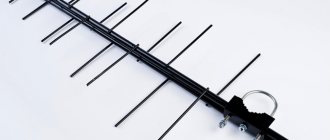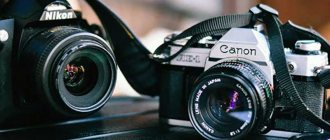Memory is an unreliable thing, so in order to preserve important moments for a long time, humanity has come up with various types of art of “capturing” reality. One of the most popular is still photography. Moreover, with the advent of almost every person having a smartphone, this type of art is becoming even closer.
However, professionals and many amateurs still advise using special photographic equipment: DSLR, mirrorless or compact to obtain high-quality results. How not to get lost in the variety of models offered and what is the difference between a DSLR, compact and mirrorless camera? How are these devices different? Find out in this review!
Before starting to get acquainted with various types of photographic equipment, it is worth making a special reservation. What exactly refers to a digital or SLR camera?
What is a digital SLR camera? These are compact SLR cameras that not only have a processor, like all digital ones, but also the presence of a special system of glass and mirrors.
A simple SLR camera with only mirrors can be electronic, or maybe film (for example, digital and analog cameras).
And now in more detail about the principles, pros and cons of each camera.
Camera design
What you can immediately pay attention to when comparing a regular DSLR and a compact is the dimensions, so the first difference between a DSLR and a digital camera is immediately visible. Due to the complexity of the system, a DSLR camera looks and weighs much heavier than a compact camera.
And, in addition, the lens adds weight to a SLR camera. A compact camera does not have the ability to change eyepieces, so the mass of the compact “out of the box” will be its final weight.
What types of cameras are there and how do they differ?
Non-system cameras
A non-system camera is a camera for which the manufacturer does not develop various system accessories. Such a camera is in some way a “thing in itself”. These cameras tend to be difficult to adapt to types of photography for which they are not intended.
Non-system cameras are not necessarily amateur cameras. Some cameras for special types of photography are also not system cameras. Non-system cameras include some specific cameras designed, for example, for shooting panoramas. Such cameras include the Horizon camera with a rotating, non-replaceable lens, which allows you to obtain panoramic images on film.
Reflex camera
What is a SLR camera? The first type of cameras is more complex due to its multi-component nature and operating principle. A DSLR also has more functions and modes than a simple compact. DSLR cameras have many lenses inside them, so a significant disadvantage from DSLR devices immediately appears - such a camera cannot be dropped and is better carried in a special bag or case.
The DSLR consists of two parts: Body or body, body plus kit lens. What does this mean among photographers? The body is the body itself, which contains all the glass and hardware, and the other half is the removable eyepieces.
As standard, all models come with a fairly ordinary lens, with which you can still get very good pictures. Their quality is far superior to a simple system unit.
Important! If you want to practice photography as an art, shoot distant or moving objects, nature, or turn to portrait photography, you will need to purchase different lenses: portrait, wide-angle, lens with a good zoom (increase), etc.
Inside the lens itself, unlike a digital camera, you can see lenses standing in a row and a diaphragm - a special plate that controls the amount of light falling on the matrix. Noise and color reproduction, and the overall quality of the entire photograph, depend on a properly functioning aperture.
An image using a SLR camera is obtained as follows:
- Light passes through the lenses.
- Then it hits the diaphragm.
- After the diaphragm, it floods the translucent mirror, dividing into two light beams. The first one is sent through rows of mirrors and passes a convex lens.
- The next stage is the pentaprism, where the light beam splits into an image and goes into the viewfinder. There the picture is already in the correct form, not upside down. And we see the result that we want to get by controlling photographic equipment.
- The second beam of light goes into a focusing system built on electronic sensors. They calculate whether an object is in focus. If not, then the lenses begin to shift a few degrees to make the image clear and “catch” focus.
- At the very end, when these two parallel processes come together and the photographer is satisfied with the image in the viewfinder, it’s time to press the shutter button. After which the mirror system moves aside, and the light completely falls on the matrix, fixing the desired image on it. Photo is ready!
Note! The difference between a DSLR camera and a compact camera is significant! The entire system of a SLR camera is built on the elementary physical laws of refraction and reflection, so there can be no distortion in the final photo. The image will turn out the way it was focused and taken by the photographer himself!
Samsung Galaxy NX Camera
The Korean manufacturer focused on the intelligent capabilities of the camera, providing the Galaxy NX model with Android OS. The design of the device also turned out to be unusual - the design is made in a large but flat form factor, which is praised for its ease of physical handling. The increase in size relative to previous versions of NX is due to the use of a 4.77-inch diagonal LCD display. As for shooting capabilities, high quality images are ensured by a 21.6 megapixel APS-C matrix, electronic viewfinder and autofocus. Communication capabilities are implemented through Wi-Fi and Bluetooth. HDMI and DLNA interfaces are provided for communication with video and audio equipment.
Thanks to the Android platform, the Galaxy NX system camera also has the ability to program photo settings through the iFunction option. In particular, such parameters as photosensitivity, shutter speed and aperture, white balance, etc. can be quickly auto-corrected. What is also noteworthy is that the device supports a GPS navigation system, and with a SIM card installed, it can work with SMS messages. Overall, the result was a high-tech smart device that significantly expanded the functional range of system photographic equipment without reducing the basic shooting quality in its class.
Compact camera
What is the difference between a system camera and a DSLR? The design of a compact, unlike a DSLR, is much simpler. This is a unit with a one-piece body and a built-in lens.
The principle of operation and image acquisition is the same as that of a SLR camera, there is no difference here. However, light passing through a set of lenses is not separated into the viewfinder and the foam prism. The light immediately hits the matrix, and after processing the image by the processor, a photo comes out.
In fact, the photographer here is the equipment itself, and the owner of the compact is the customer who needs a specific object in the photograph.
Therefore, the disadvantage of a compact unit is that the processor processes the image in its own way, not allowing you to change the final result, which is easily possible in a DSLR.
Digital cameras are also divided into several classes based on the principle of applicability. There are reporter, studio, panoramic, etc. soap dishes.
These cameras have a built-in flash, and there are several standard modes, for example, conventionally called portrait, landscape, and macro photography.
The soap dish saves its files in JPEG format, unlike a DSLR, which creates a raster image when shooting. Why is a mirror device better at this point? A raster image is a picture, which is then very convenient for professional designers to develop in Photoshop. A digital camera does not have this privilege.
However, the following interesting “gadgets” can be found in system cameras:
- Interchangeable attachments for an already built-in lens, for example, to create a “semblance” of a wide-angle image.
- "Hot shoe" This is a special plate at the top of the compact where you can attach a removable flash or image stabilizer to make the photo as clear as possible.
- Manual focus. A relatively new thing, since the focus is still controlled by the processor itself. What's better? Determined by the owner of the equipment himself.
- Powered by any batteries. It's not always convenient to have a battery, which suddenly happens! and discharged. Standard AA batteries are sold everywhere, and the problem can be solved very quickly. This is where the digital camera compares favorably with other cameras. With a DSLR camera, this can be solved in an instant only with a special spare battery.
Model Fujifilm F X-T10 16–50
Also a budget-level camera, equipped with a 16-megapixel matrix, but with a wider range of functional tools. The company used innovative hybrid autofocus technology, which “guides” the subject even when the body is actively moving. The frame rate of the F X-T10 16-50 system camera is only 8 frames per second, so this choice is more suitable for a beginner photographer. But what it lacks in performance it makes up for with a fast viewfinder with 0.005 second lag, a flip-out LCD screen and a built-in flash. Once again, it is worth emphasizing the successfully implemented design in the style of devices of the last century, which distinguishes this line from more technologically advanced competitors.
Differences in the design of compacts and DSLRs
DSLR or compact? In addition to the obvious differences in operating principles, a DSLR camera differs from a regular compact camera in focusing functionality. A SLR camera has an optical focus, as optics work - a system of mirrors and lenses. Compacts are electronic; the focus is monitored by a processor. This is why compacts are often popularly called “point-and-shoots,” because due to the automatic focus, the processor sometimes likes to “blur” images, making them unclear.
Besides this, there are a few other differences:
- Lenses. Compacts do not have a mirror system, but their lens can be much better than a regular kit lens on a DSLR. This lens is called “ultrazoom”. It allows you to shoot any objects at a fairly good zoom, for example, 40,50 or even 60 times.
- Additional funds. Digital or DSLR? Sometimes a photographer needs additional tools, such as a flash or an off-camera microphone. You can’t connect such things to a lightweight compact. And the battery won’t last, because a DSLR camera lasts much longer.
- Charger. Is it better to have a mirror or a system compact? The compact, relatively speaking, has enough battery power for 200-300 shots, if no one drains the battery and looks at the results of the shots on the display. And the display itself is smaller and much worse; it is grainier than that of mirror models.
- Matrix size. It seems that this is not a critical parameter, but it means that the larger the matrix, the correspondingly more light it will collect upon itself when the shutter is released. And the quality of the final picture increases based on the amount of light collected. Which matrix is better? Now the most popular is the full-size 24*36 mm matrix, which can be found in expensive SLR models. The matrix of compacts can be 13*18 to 22.7*15 mm, which also allows you to take acceptable photographs. For comparison, even the most expensive non-mirror compacts cannot have a matrix larger than 8*6 mm, and sometimes it can be smaller.
- Lens material. In addition to the lack of mirror optics, compacts also suffer from the material of the lens system itself. The DSLRs have them made of glass, while the compact ones have plastic ones.
- Price. This is also where a DSLR differs from a digital camera. The price of non-DSLR cameras can be equal to a quarter of the cost of a DSLR camera. Good models start from 5,000 rubles, and the price of SLR cameras starts from 25,000 rubles for standard equipment (body plus lens).
Specifics of system devices
Olympus, as well as Panasonic, initiated the production of compact camera models that refused to use mirrors in them. System devices are devices with a modular design, including a core and replaceable elements.
In system devices, light passes through the lens and immediately hits the photosensitive device. The viewfinder here, accordingly, is not a mirror one, but a telescopic or electronic one (additional display).
In the latter version, the camera processor reads information from the matrix and displays it on the LCD display in Live View mode, which is also available on DSLRs.
Despite the peculiarities of system cameras, most of them have good matrices, and it is possible to provide additional equipment. If previously such cameras were single-lens, now this limitation has been overcome.
Functionality of compacts and DSLRs
Compact fans always argue with DSLR fans about functionality. What is the difference? Here it is important to consider the main thing - for what purpose does a person take photographic equipment? If you need a simple device that works on the principle: “click” - “here is a photo,” then a compact is the best option.
No need to bother with settings, know the basics of photography, etc. For a point-and-shoot camera, the most important thing is to capture the desired frame with little loss. Yes, the image may have noise and may be slightly blurred, but this is not critical, however, a photo for memory is taken extremely quickly. You can quickly zoom in or out on an object, as well as use several filters after shooting with the camera.
So, SLR and digital...
DSLR models are much more than just a camera. It is no coincidence that the camera is called a SLR, that is, the best reflector. These cameras offer a lot more room for experimentation than digital ones, especially in manual mode. Changing the focus, changing the shutter speed, adjusting the aperture time is easy!
Only for this you need to understand the instructions well and learn the basics of photography. For beginners, there is on-site practice - an automatic mode that will help you learn everything in the field.
Thanks to better focusing, the DSLR camera offers clear continuous shooting and panoramas without loss of quality. And, of course, color rendering... DSLR cameras even have interchangeable filters to play with color and make the end result a real work of art.
Panasonic models
Of course, Panasonic also includes in its assortment completely “its own” developments of system cameras. This segment is represented by the DMC series with several versions. The Lumix DMC-GF7K, intended for beginner amateur photographers, is considered the basic one. The device is equipped with a rotating display, accurate and fast autofocus of the Contrast AF system, a built-in flash and a Wi-Fi module. That is, in terms of basic functionality, this is the best entry-level system camera, but there is also a more advanced modification - the DMC-G7K. This camera supports 4K video recording at 25 fps with a matrix resolution of 8 megapixels. But the creators pay special attention to high-contrast DFD autofocus, which captures objects in 0.06 seconds, allowing 6 frames per second in continuous focus mode. This system only works with branded Panasonic lenses.











